
Hair transplant surgery has become a popular solution for individuals experiencing hair loss, providing a permanent and natural-looking solution. However, as with any surgical procedure, the recovery process is crucial for achieving optimal results. In recent years, Hyperbaric Oxygen Therapy (HBOT) has gained attention as a potential aid in enhancing the recovery process after hair transplant surgery. Let’s explore how HBOT can contribute to faster healing, reduce complications, and improve the overall success of hair restoration.
Understanding Hair Transplant Recovery
After a hair transplant, the recovery process typically takes several weeks, during which time patients may experience mild swelling, redness, and scabbing around the transplanted area. The newly transplanted hair follicles are delicate, and the healing of the donor and recipient areas is critical for the success of the procedure. The following are key phases of hair transplant recovery:
- Initial Healing (First Week): Swelling and discomfort may occur, with scabs forming around the transplanted follicles. Proper wound care and avoiding infection are essential during this phase.
- Shedding Phase (2-4 Weeks): It’s common for the transplanted hair to shed within the first few weeks. This is a normal part of the process as the follicles enter a resting phase before new hair growth begins.
- Growth Phase (3-6 Months): New hair growth typically begins a few months after the surgery. This hair is often thin at first but gradually becomes thicker over time.
- Full Results (9-12 Months): It takes up to a year for the full results of the transplant to be visible, as the hair continues to grow and thicken.
The recovery process can vary depending on the individual, the technique used, and post-operative care. During this time, minimizing complications such as infection, poor circulation, or inadequate oxygen supply to the transplanted follicles is critical for success. This is where Hyperbaric Oxygen Therapy may offer significant benefits.
What is Hyperbaric Oxygen Therapy (HBOT)?
HBOT is a medical treatment that involves breathing pure oxygen in a pressurized chamber. This increases the oxygen concentration in the blood, which can help enhance the body’s ability to heal by promoting cell regeneration, reducing inflammation, and fighting infection. Originally developed to treat decompression sickness in divers, HBOT is now used for a variety of medical conditions, including wound healing, infections, and tissue repair.
Benefits of HBOT for Hair Transplant Recovery
- Enhanced Wound Healing: HBOT helps to improve the oxygen supply to tissues, which can accelerate the healing of both the donor and recipient areas after a hair transplant. Oxygen plays a key role in the regeneration of cells, collagen production, and tissue repair, all of which are crucial for a successful recovery.
- Reduced Swelling and Inflammation: Swelling is a common side effect after hair transplant surgery. HBOT has anti-inflammatory properties, helping to reduce swelling and promote faster healing. By reducing inflammation, the therapy may also help prevent complications such as folliculitis, an infection of the hair follicles.
- Increased Survival of Transplanted Follicles: The success of a hair transplant depends on the survival of the transplanted follicles. Adequate oxygen supply is essential for follicle survival and growth. HBOT can improve blood circulation and oxygen delivery to the scalp, enhancing the chances of successful grafting and hair regrowth.
- Prevention of Infections: Infections can jeopardize the success of a hair transplant. The oxygen-rich environment created during HBOT sessions helps to inhibit the growth of harmful bacteria, reducing the risk of post-surgical infections.
- Minimized Scarring: Scarring is a concern for many hair transplant patients, particularly with traditional strip procedures. HBOT may help reduce scarring by promoting collagen production and tissue repair, leading to a more aesthetically pleasing outcome.
Incorporating HBOT into Your Recovery Plan
While the exact timing and number of HBOT sessions needed can vary based on individual factors, many patients begin HBOT treatments within the first few days after their hair transplant surgery. A typical protocol might include daily or every-other-day treatments for the first week, followed by periodic sessions as recommended by the physician. The non-invasive nature of HBOT makes it a convenient addition to post-surgical care.
It’s important to note that while HBOT shows promise in improving hair transplant recovery, it should not replace standard post-operative care but rather complement it. Patients should always follow their surgeon’s aftercare instructions, which may include medications, avoiding sun exposure, and proper scalp hygiene.

